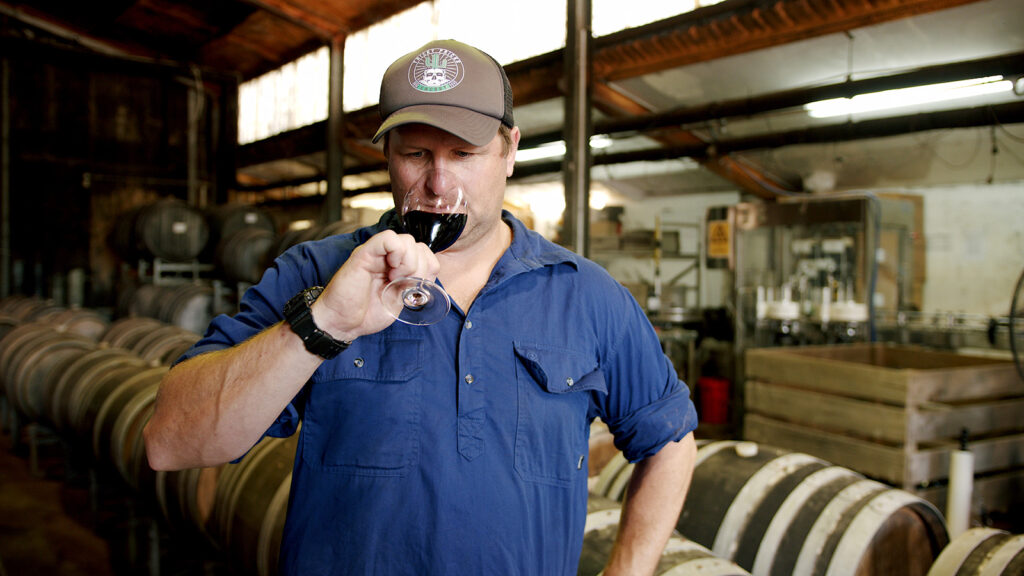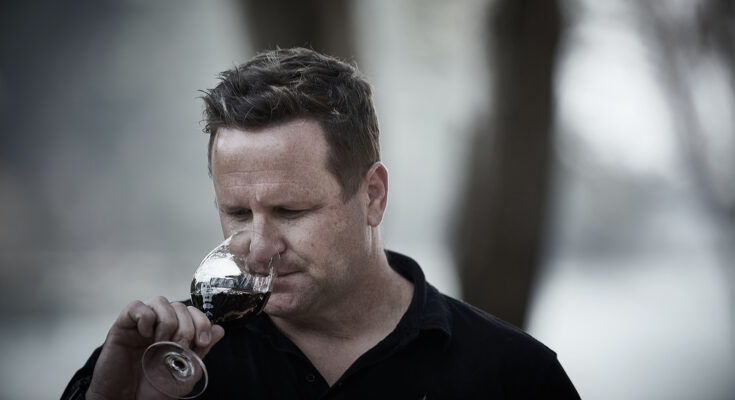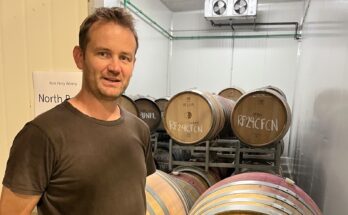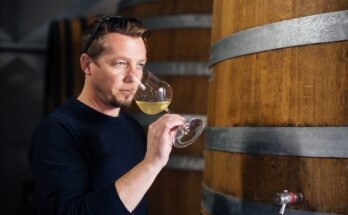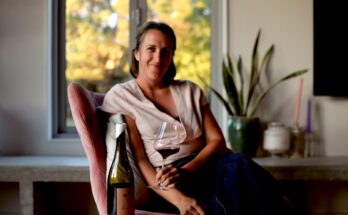For the first ‘proper’ WineFolio Field Trip to Waiheke Island, I wanted to call in and see some of the headline names on the island. With that in mind, day one saw the WF-mobile heading over to the eastern side of the island and an early morning catch up with Man O’War winemaker Duncan McTavish. We pull up outside what looks like a pretty big, new building – only to be told “power’s out, hopefully the generator holds”…
Duncan McTavish: New winery, bottling line etcetera, makes for comfortable digs. I’ll give you a quick look around. We’ve just got the 2021 Bordeaux laid out for a taste, topping and test if they’re going through malolactic or not. That’s all late malos – most of them haven’t finished. Some of them haven’t even started – but we don’t mind that. These will all stay in barrel through to next September or October. And that’s a pretty amazing vintage. We’re lucky to have three in a row.
It’s nothing flashy but we’ve got everything we need. Bottling helps with the scheduling as we’re flying by the seat of our pants sometimes. We get to absolute full capacity by the end of harvest. Then it is juggling things around, trying to get the scale of the blends. The pressure for us right now is to decide the Chardonnay blends for 2021 so that they can be cold-stabilising over Christmas break. Then we get back, we can get those into bottle. Get the 2020 Ironclad into bottle and start picking grapes. Happy Days.
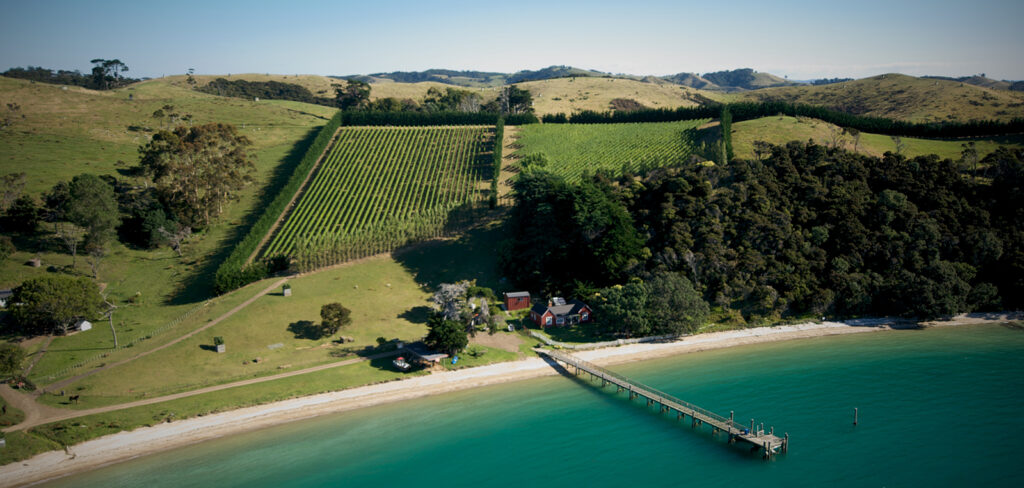
We have seventy-odd vineyards all over this end of Waiheke and Ponui Island as well. The scale is enormous, the diversity is enormous. The varieties that we grow are pretty diverse, so we have a lot on our plate. It’s also reasonably unusual for the New Zealand landscape that we are Cabernet Franc and Merlot dominant for our Bordeaux blends. John Spencer didn’t really drink – it was more his wife that enjoyed a good Pomerol. In conjunction with that I think it fair to say that the drive towards Cabernet Franc Merlot blends was also driven by the clay soil and cool climate which favoured those Pomerol style wines (Neal Martin considers Cheval Blanc a Pomerol wine rather than a St Emilion wine) and that direction was developed in consultation with Jim Vuletic of Providence and Kim Goldwater of Goldwater Estate.We do have one Cabernet Sauvignon vineyard which is excellent, but the majority of our Bordeaux is Cabernet Franc.
WineFolio: It’s good to have that vision, right from the start. To have something to aim for.
DM: And looking through generations as well. Not just about the here and now, which probably goes some way to explain the scale of the place. We’ve got really good direction.
I was in North Canterbury – I’d been at Pegasus Bay for four years, and went to a little place called Waipara Springs where I was Head Winemaker for four vintages. I was really looking for something a bit different – I’d studied winemaking in Canterbury as well. Going overseas was my OE – four to six week stints here and there. I saw a winemaking job on Waiheke advertised. I’d never been to Waiheke before, and after thinking about it I realised I’d never actually had a job interview in my life.
So thought ‘to hell with it, I’ll apply’ and wanted to see what would happen. Came up here – met the owners – had an interview with an HR Consultant, which was reasonably painful.
WF: Oh God. I hate that sort of thing. I’ve walked out of one of those before – I just can’t wear the mask you need to, to pass that sort of thing. I do think you need to be fairly honest with yourself, of course – but also be comfortable in your own skin.
DM: Next thing I know I’m heading to North Shore Airport, then up in the air. Flew over here, and over the vineyards. I thought to myself that there’s nothing of this scope and diversity in New Zealand. When I arrived there were 98 vineyards. I was continually getting lost driving around this place. A huge array of vineyards, and one of my first jobs was to really evaluate the landscape. It is hard to make a business in the wine game, and there was a really strong desire to focus on quality. That’s what we had to do, and we selected our best sites, the weakest sites, the most vigorous sites. We removed the ones that produced more leaf than fruit! But then, 8-10 years later, the rise of rosé…hahaha – and those are the ideal vineyards for rosé…. high cropping, low brix.
WF: So being asked to make a big Bordeaux red, alongside Syrah… daunting?
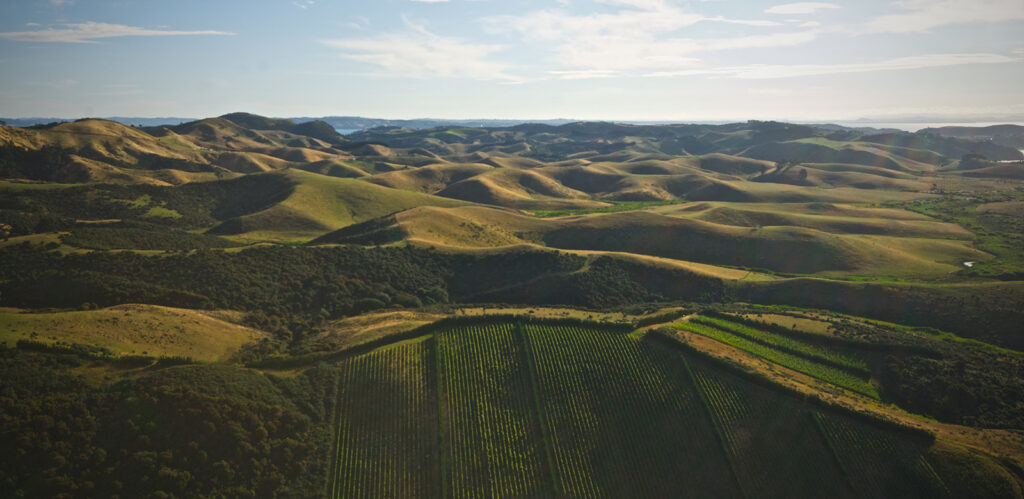
DM: Well I’d done a couple of harvests at Napa. Came from a Riesling, Chardonnay and Pinot background, but backed myself to make some wine! A lot of the Pinot techniques relate well to Syrah. Also with Cabernet Franc and Merlot – there’s no massive amounts of crushing, rack and returning – that kind of stuff. It was all pretty gentle from the get-go.
Whilst we’re chatting away, we can have a look at Chardonnay. I thought the best way to show what we’re up to is to look across the tiers. We produce our Estate, the flagship Valhalla, and the new gold label. We have a good understanding of all our vineyard sites, and these are vineyard selections, which correlate with picking decisions. The earlier picked stuff is the Estate, and then the Kulta is a selection of barrels.
We’ve evolved and moving into that real, positive, herbaceousness in Chardonnay. Trying to capture that and showcasing classically ripe characteristics in wine, but also highlighting some of the more interesting aspects of the green notes. Whether that’s like a fleshy green nectarine, picked from a tree, crisp and clearly ripe – but it is a hell of a lot different from something that’s been sitting in the fruit bowl for a week. Both technically ripe, but one’s crisper and showcasing some of those crunchy green notes. That’s an interesting proposition for Chardonnay – particularly since Valhalla has always been looked at as ‘a big style’. That’s where we’ve been channelling ourselves.
Everything is full-solid ferments, wild yeast and then nothing else. There’s no malolactic or lees-stirring, just trying to keep it very direct.
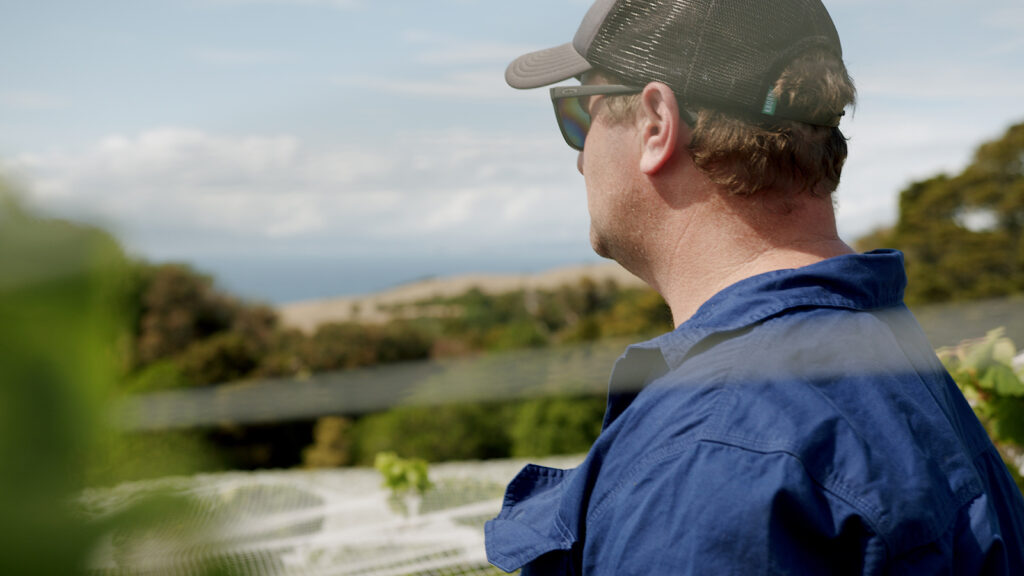
WF: So you’re not after malo?
DM: No, we’re a very ripe environment, so one of the pillars of wine structure, alongside acid and tannin, is alcohol – or sweetness – and alcohol will provide all the mid-palate that we need. And it is our job to manipulate the structure. 2021 was a very ripe, low-yielding year, and they are very expressive already.
These are all 2019s, which was a terrific vintage, albeit the highest yields we’ve ever seen. Not overcropped by any stretch, but certainly from a historical perspective we had some really good yields. And we’d come off the back of a couple of tricky, cyclone-hit vintages. ’19 was the last vintage down in the old winery and it was huge. Then we came up here and we had a couple of nice, dry, calm, modest-sized vintages, which was good. And I think we’re in for another big one.
WF: So, the Estate Chardonnay – this is picked for this style that you’re after?
DM: Yes, they are earlier picked for sure. Some of the reasons might be that those particular vineyards can be prone to botrytis if they are left hanging out too long. Other reasons are that they are right up here on a volcanic plateau and quite exposed to the Pacific Ocean. They get to a level of ripeness and that’s it – there’s no point pushing them along any further.
You’ll notice these huge boulders strewn across the hilltops as the result of volcanic activity, and we have a unique soil type up here. A lot of our Chardonnay is planted on those sites and it is pretty mineral, and salty as well.
WF: You can taste the salinity in there. It doesn’t look like limestone though, for example?
DM: No, it’s clay but iron-rich. There’s a very small deposit of volcanic material, but the main feature is the exposure to the Pacific Ocean.
WF: and do you experiment with different clones, or is that not thing for you?
DM: No, these are all the same clone – Clone 15.
WF: That’s got an almost briny, green olive character to it.
DM: It’s a great feature of a wine. We had a Master of Wine come through at harvest, tasting Chardonnays that had just finished ferment, and talked to me about Succinic acid. It’s a sensation of salt – they call it the winemaker’s acid.
WF: And do I recall you saying that with oak, you’re often looking for low, or even un-toasted oak?
DM: The Estate Chardonnay has maybe 10% new oak in it, and, funny, the French don’t like sending out barrels with zero, zero toast – no matter how we stress that we don’t want any toast. We use 500 litre puncheons. We’d love to get our hands on some 3000 litre big boys, but we’re a way away from that. Our stock barrels would be the Medium + but we work with a couple of coopers who have moved into light toasting which is pretty discrete. For me, and our wines, brings out even more of that greener, herbaceous notes and you get that really lovely oak aromatic… just not toasty. We’re trying to understand how those barrels work with the wines.
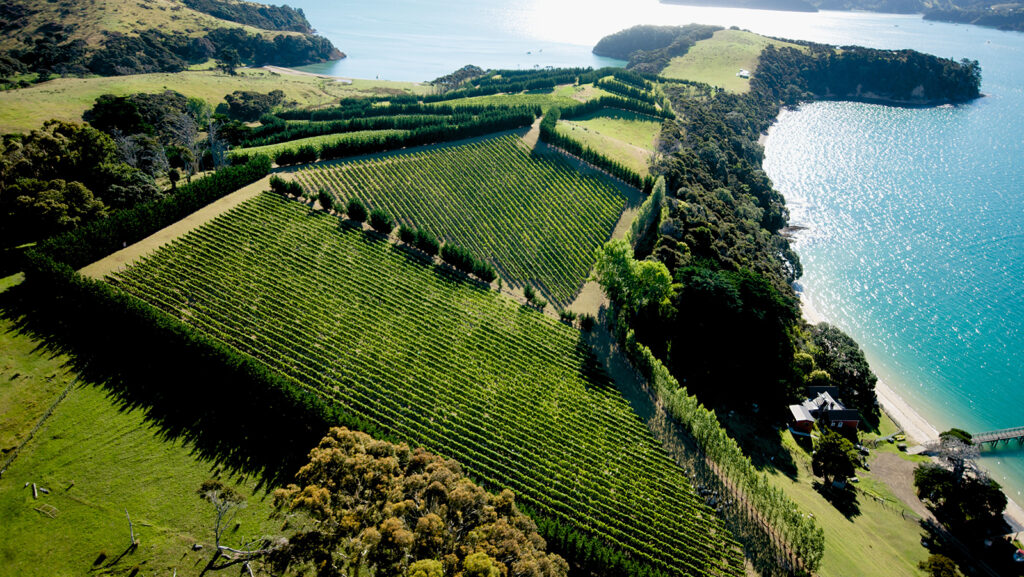
Everything is full solids and not reduced in terms of a yeast reaction. I call them fruit sulphides – that flintiness. It is a by-product of the levels of solids that we leave in the juice. Whole bunch pressed, we probably get about 5% solids. If you macerate, either by feet or by pump, you get about 10% solids. You get far more of that flinty complexity with more solids, than you do the fruit expression with less solids. Obviously you get a lot more tannin and then you’ve got to work out how to fit that tannin into a wine. Tannin and acid are old mates from way back, and then you’ve got the power of the alcohol. We don’t want anything to add width to the palate – just trying to be nice and linear. We’ve never done any malolactic.
WF: I do feel that the Valhalla has changed over the last ten years.
DM: The thing with the early Valhalla and Dreadnoughts is that it’s about making a statement. You want to capture people’s attention and stand out from the crowd. The move to low or no toast is in the last three years. It actually started in reds – doing it in Syrah first, then pulled it into Chardonnay. The biggest difference between the earlier vintages and now is botrytis. The early vintages, the vineyards were young, getting very ripe, and incidents of noble botrytis. We did full solids, with or without the presence of botrytis and made these big, funky, rich wines – into that apricot spectrum. And they were cool. They were killer wines.
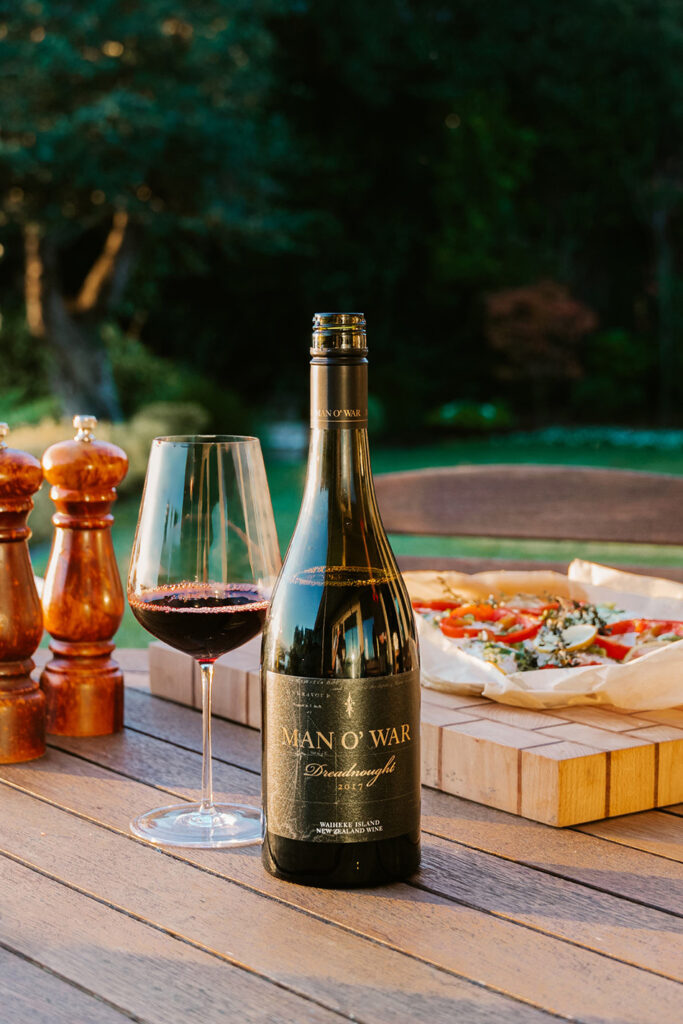
WF: They were noticeable wines.
DM: But that came with a compromise, and, for those, it was their longevity. I could open one now and they look like Noble wines – they are deep and dark in colour. And if you served them in a black glass you would still find them incredibly youthful expressions of Chardonnay. But. You taste with your eyes a lot as well. The movement towards a more linear and focussed style of Chardonnay is very much around protecting our crop, because we’ve got to be economically sustainable as well as everything else. Early picking and avoiding botrytis at all costs, because if we want to be an iconic producer, people have to be able to pull your wine out after ten, fifteen years are be able to really admire and enjoy them. It’s not good enough for them to be awesome when they are young and then fall over five or six years later.
If you want to aspire to be up there with the best, then you’ve got to be able to showcase your skills at making wines that can last ten, fifteen, twenty years.
That’s hard when vineyards are inherently young, and you’re still working out flavour profiles and winemaking styles. You’ve got to aim for something. We learnt a lot from those cyclone-hit vintages, in ’16 and ’17, because prior to that we were picking ripe and it was all about power and being really expressive. Now we’ve learnt a lot about picking earlier and building restraint into our wines.
WF: Is that something that came from you, or was it decided by ‘the company’?
DM: No, I have free range to do whatever I want. Again, it comes back to a need to stand out from the crowd and make a mark. Styles of wines like Exiled – sweet Pinot Gris, from New Zealand? If someone came to me twelve years ago and said ‘would you like a glass of sweet Pinot Gris from New Zealand?’ I’d have said ‘no thank you’. Which is what our Sales people at the time said to me. And I said ‘that’s fine but I’ve just made 5000 cases’. And that’s grown to be one of our biggest areas of production – Pinot Gris in that off-dry style, with around 20-30 grams RS. We own that little spot. Now we have a style, with Exiled, that can live for fifteen years and be incredible.
With picking earlier, greener, and the wines are fresher and all the better for it. Then we are able to layer in more interesting things like tannin – fruit tannin from the solids – and all that sort of stuff.
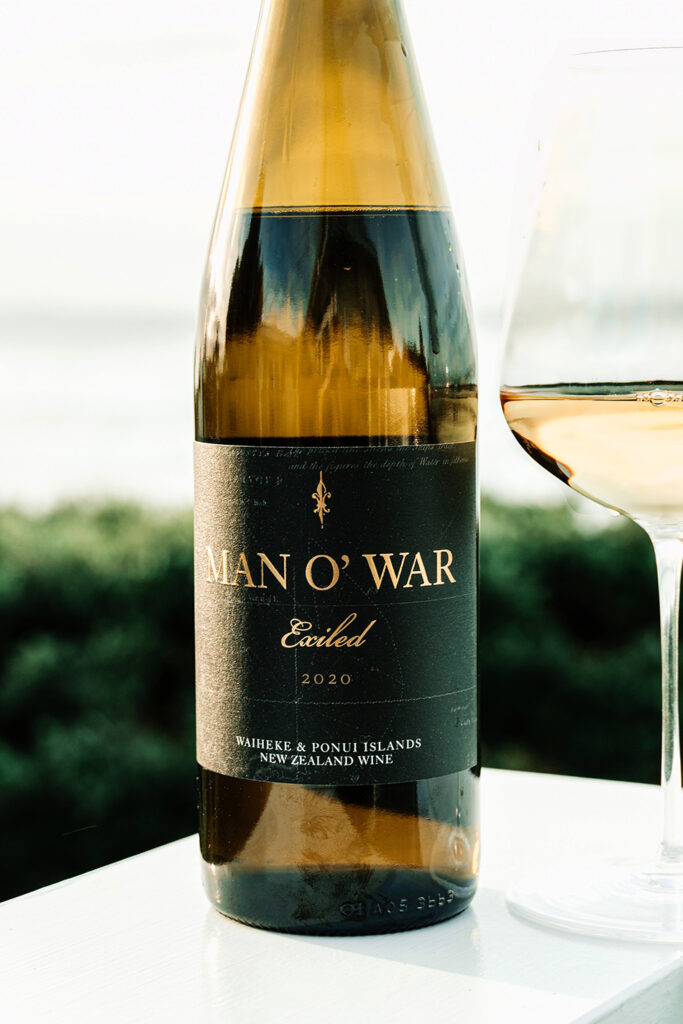
Similarly, with dry rosé – we’ve managed to get ahead of the curve, with Bordeaux varieties and a dry style, in New Zealand. Rosé in New Zealand was, still is, all about Pinot – quite often saignéed Pinot – so potential alcohol is high, and leaving a bit of RS in the wines so they don’t get too high. Just that style. And we wanted to make something that’s bone dry. And that’s been incredibly popular. We hope that the customer understands what we’re trying to do.
WF: I think that both the Exiled and the Pinque are becoming iconic wines of their type, which is great for the Man O’ War brand – so it’s not just Valhalla and Dreadnought in those classic “fine wine” styles, but going through a whole range. Good on you for creating wines of personality that you’re not even sure that the market will embrace.
DM: Sometimes it is a blessing and a curse to be making wine in isolation as we are down here. Also lucky that we drink a lot of wine! And to me it is as much about deconstructing styles of wine and figuring out ways and means of re-constructing them. It’s not like going to France and seeing how they make wines, and coming back to New Zealand and doing the identical techniques. Because that quite often doesn’t even work. If you can taste a wine and go “wow, I really like that tannin profile… or that line of acid” and then work it out and play around.
This is the first release of Mathilda. These are named after family members. This is a selection from two or three of our very best vineyards, and then some of the more avant-garde barrels that we have I the cellar. We use a bit of acacia as well which is quite distinctive – it gives a real ‘green smoke’ to a wine. There’s not a huge amount in here. We do put some in the Sauvignon-Semillon.
We’re using a Coopers called Billon, and a lovely lady called Roberta who is their agent in New Zealand. She has got amazing knowledge, and we talk to her about what we want, what we’re tasting and what we dream of where our barrel profiles could go. She makes suggestions about barrels they’re working on, and they will create bespoke barrels for us. They’re happy to make one or two of these barrels for us. It might seem like a pain in the arse, but it is of interest to them, and certainly to be able to work with someone like that, is awesome.
WF: Do Coopers ever ask for samples of the wines you have made, or do make, with their barrels?
DM: No, hahaha.
WF: And is it 100% new oak in this wine?
DM: Probably closer to 60%. A lot of those puncheons are incredible after one year. So, seasoned. That’s where we’re actually seeing the real bang-for-buck out of them. A lot of the new barrel portion will sit in Valhalla or Dreadnought or Ironclad – and then, the following year, they’ll be straight into our top wines. It’s all pretty new.
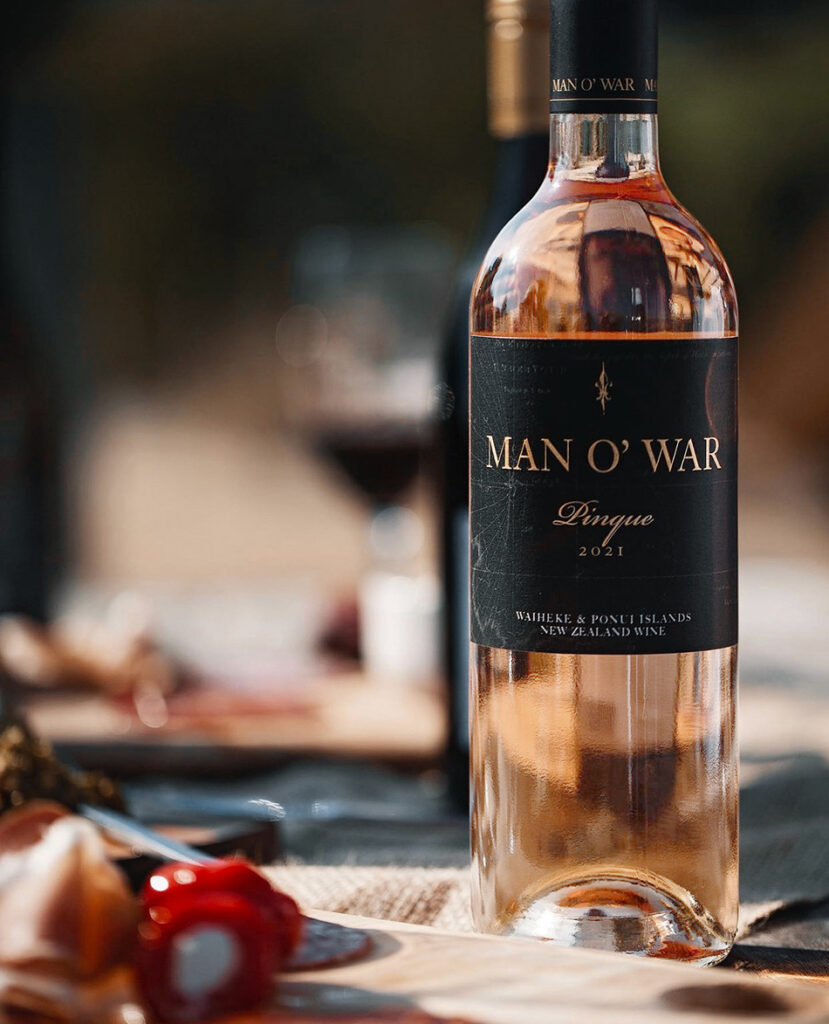
The vineyards we use for these wines are naturally low-yielding – we might get one kilo per vine. We have a lot of hen and chicken as well. It is a challenge when you’re making a Chardonnay that sits on the shelf for $28-30 and you’re utilising those kind of yields.
Hopefully there’s a lineage and you can see the guiding hand of the winemaking team and the style of the house, so to speak? Clear steps. We want to appeal to a good, broad range of winelovers with Valhalla – that’s where our reputation has been forged. The Kulta – we only make 100 cases of that wine, and it is getting people on to that journey as we figure out what that wine should be, and how it should taste – and age. We get a lot of feedback ‘I love Valhalla’ ‘We had it at our wedding’ and things like that. And that is awesome. We try to offer as much value as we can – the Estate level are all really cool wines, and good value for money. A lot of companies – that Estate would be their top level Chardonnay.
WF: What about the top end? How’s that been going?
DM: Again, it is really small production. With COVID it has been hard as we would normally have done two or three tastings where we explain what we’re up to. We’ve got a good following so that people can trust to spend $100 on a bottle of Chardonnay and know it is going to be pretty unique. For us it is about trying new ideas and pouring it into a bottle. We will try and do a Mathilda every year. It might be 50 cases or 100 cases, but it is a bit of a journey in terms of figuring it out. We’ll find what really excites us. It would be awesome to be getting 100 points for those wines but that’s not the reason we do it at all.
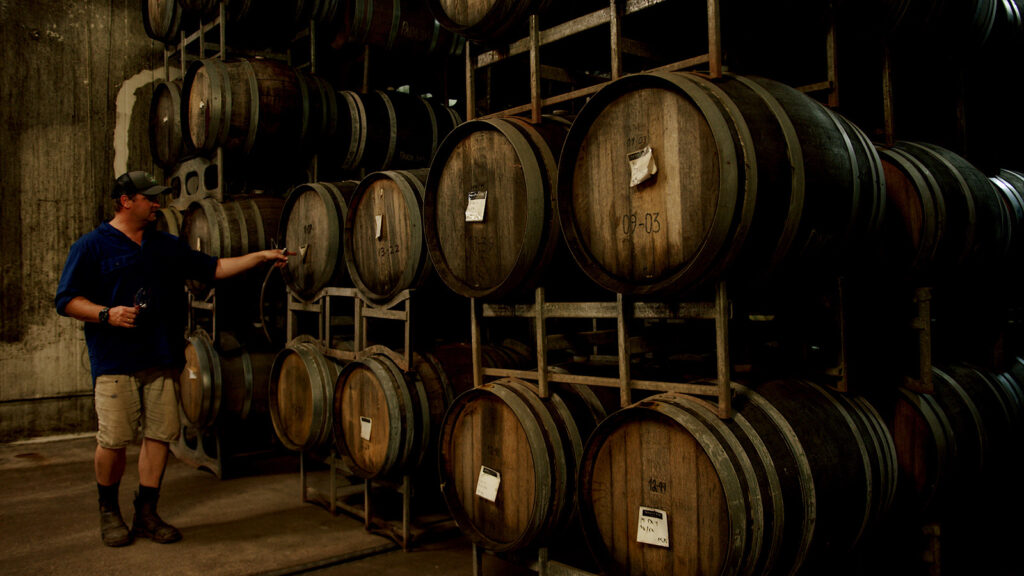
WF: I guess that’s something I wanted to ask about. At some point these wines are going to be harder for Joe Public to get. So there’s a the Man O’ War Family Membership thing, and Kumeu River have their Cru Club as I suppose they’ve seen that the wines will be become harder to get – so to ensure an allocation “join the club”. So, Felton Road, Kulta, Matés are going to be internationally recognised and hard to get wines.
DM: Yes, but first and foremost they have to be really exciting for us to make, to drink. We want to be really excited in 2028 when we open it again and it has really got to where we wanted it to be.
WF: I got hold of a few and certainly have no intention of opening them for a few years. What do you think about New Zealand Chardonnay and ageing? Is there anything that warrants going beyond that 8 year sweet spot do you think?
DM: For a start it is hard to find a New Zealand Chardonnay with age on it. People just drink them. I know from our experience that it is a real focus for us. From what I see, and not just New Zealand wines, is that wines peak at 8-10 years. After that you get all these tertiary characters coming in and whether you’re a real fan of those depends on what you like. I bet a lot of people would like to drink their Cheval Blanc young, and if they tried a 20-year old one it wouldn’t be their cup of tea.
WF: Do you think that winemakers are also getting smarter at presenting wines on release so that that freshness is very appealing without needing age? Within 45 minutes of a bottle being purchased, it has been opened – so the majority of people who get a Valhalla are drinking it immediately. We don’t really have wine cellars now?
DM: the other point that needs to be made on that – is that our vineyards would, on average, be 18 years old. So the seven year difference between a 2012 and a 2019 – that’s a lot of time in that vine’s life.
WF: So, are we in a sweet spot – with vineyard age, winemaker, vineyard managers age (and experience)?
DM: Certainly we are seeing that in the vineyard team – everyone is getting more skilled. Unbelieveable knowledge about specific blocks within vineyards. That level of understanding goes so far towards making wine, than a winemaker. We do give feedback, so something like our top Syrah vineyard – called Madman’s – we get great communication back to say something like “Bin 16 is coming in hot”. That makes a huge difference for us. That’s what, in my mind, is becoming the difference.
WF: Do you live on the island?
DM: I live twenty minutes away, above Onetangi. I roll down my driveway and then it is just all farmland.
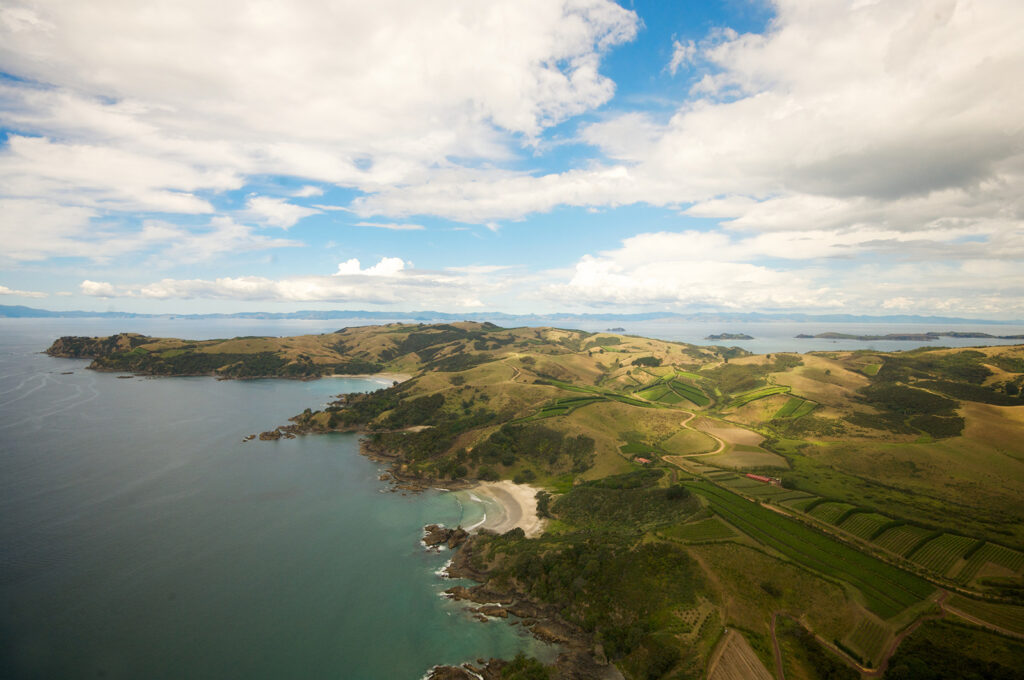
WF: Have you been tempted to do designated wines – single vineyards – like a Madman’s Syrah? Because if you’re doing 100 cases – that could be 100 cases of Madman’s?
DM: We are blenders as much as anything. We’ve such a range of sites that our natural inclination is to blend. Single vineyards was part of the thought process, but I believe that as we move forward, in ten or twenty years, the desire to understand more about producers just gets more and more. And that’s where single vineyards come in. But that’s a fraction of the wine community that is interested in that. We’d love to one day be able to showcase the twelve different expressions of Chardonnay that go into Valhalla, and then present the finished blend… Imagine an Enomatic machine and an iPad – touch this screen and there’s the winemaker talking about what you’re tasting – and then you move on to the next one, and the next one…
WF: That’s interesting, because I suppose that the Tasting room is a big part of what the public think of as Man O’ War. Is that still a very vital part of the brand?
DM: Yes, because that’s the gateway to the property. Everything has its own set of challenges. The Tasting Room is a business, and it is open door, so not like ‘Reservation Only’, and our season starts just before Christmas and goes to Easter, and that period of time is so intense. You want to give a customer a good experience, but often that is a plate of food delivered with a nice glass of wine. It’s not a half hour discussion about the intricacies of what we do.
WF: Can we try something out of barrel?
DM: Sure – we’ve racked a lot of the Chardonnay into different components. We’re really thinking about our Chardonnay needing to go back to barrel for another 6 to 12 months. We kept some 2020 in barrel for an extra year and it looks amazing. Not sure we’d be brave enough to do that to a 20,000 litre blend just yet. Here’s the same wine, 3 different barrels. Racked off gross lees.
This is our top vineyard site, at about 24 brix, and it is nice and tight – gives us our classic “Kiwi style Chardonnay”. Absolutely beautiful, but when we get into the selection for the Kulta – one of the insults we throw around is “oh yeah, that’s pretty normal” We’re trying to do something here that is distinctly Man O’ War.
All three barrels are one year old, so you can see the difference there that you don’t need to have brand new oak – they are unique characters. That impact from the barrel just completely changes the wine. That’s just one parcel.
We head back to try more wines…on the way passing by ‘the vintage wall of shame’. As Duncan explains “to get us through the day”. They drink wines blind every day, and some have “more experience and bigger cellars, and you get some really interesting stuff – part of getting ready for vintage is everyone finding awesome wines to bring as mystery wines”.
We start with a 2013 Valhalla – from a very hot vintage. It’s a darker colour – golden straw, with toast and honey on the nose.
DM: We do verticals of our wines every year, and re-release wines from our Library stock – and this is one of those wines. Goes real well out of a magnum. People perceive Valhalla as being this big, toasty, funky monster, but it still has that freshness. That’s the challenge with Chardonnay. Those tertiary flavours of apricot, toast, muesli and honey are really nice, but can you drink a whole bottle? You can easily drink one when it’s seven years younger.
WF: I think one of the key things in a good bottle of wine is the last glass out of it. Does it make you yearn for another? And regretting that that is the last drop out of it.
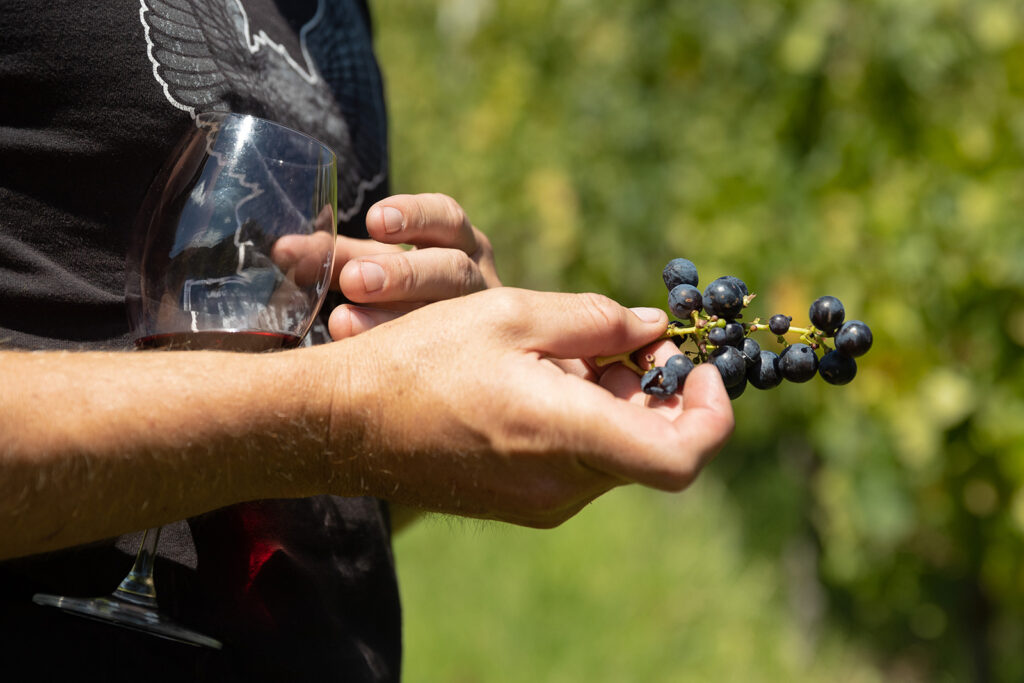
DM: That’s an essential to when you’re sitting tasting blends. You come up with a blend and then take that blend to different settings. At home, at work, mate’s places, out of a plastic cup on the ferry to the city. The mark of a good blend is something that you feel like from the first taste you can understand that wine. But then pour another taste and go ‘hang on, what’s that – I didn’t see that before..’ And then you’ve got that complexity all the way through the bottle of wine, where you think you understand it, but there’s something more each time you go back to it. And then, as a result, there’s nothing else you can do – except open another bottle.
WF: I can see elements of the Kulta Chardonnay in this 2013 Valhalla, sitting in there. The tightness at the front, the acacia, the piercing drive and a saline phenolic structure. So, how long were you working on the Kulta project before you decided it was ready to go, and bottle it as that?
DM: Since the get-go. The only way to approach a place like this where you’ve got 70 vineyards, and it is something that I took from Pegasus Bay, is to look at it as one great viticultural trial. Of all those vineyards, you are making that wine as if it is on contract and that vineyard was the only one that person owned. Rather than thinking ‘I’ve got 70 vineyards, I can get one wrong’. So you make the best wine you can from that vineyard and then you’ve got to blend that together, and understand how they all relate to each other. That takes a decade at least.
2012 is the year we started putting stuff aside. Most of them just got put back into the main blend. Some we bottled! I’ve got some 2015 in there that is just covered in dust, but it’s an awesome wine. That’s the first Syrah we did in an untoasted puncheon. Which we could taste after we do the Dreadnought if you want. The rationale behind that was that we were getting into stems at that stage and some vintages you can’t – you have to do 100% destemmed. So the idea with the untoasted barrels was to get the vibrancy and woodiness out of oak rather than stems. It goes back to that deconstruction – whether it is Cornas or Crozes Hermitage that has lots of stems, and you wonder ‘how the hell can I do that in my wine?’ And that’s how it came into Chardonnay – it all came from Syrah!
Before we go to red, I’d like you to try this – this is Sauvignon-Semillon, so Bordeaux Blanc. This is made the same way we make Chardonnay, it just comes off gross lees earlier. So it is 100% full solid, wild ferment – hot ferment – we ferment our Chardonnay and Sauvignon, hot, hard and fast. Helps build the glycerol and helps minimise over fruitiness. And we are just about to release this wine. I almost feel sorry for it – that it is called Sauvignon Blanc, because most people wouldn’t be releasing a 2019 Sauvignon Blanc based wine with any degree of excitement.
For me it is just a really awesome dry white wine. It’s irrelevant what it is made from. It’s thought provoking – with those salty, saline elements. It’s got the green notes that I love. I love this wine, but it is a tough, tough one to get out there and get other people to love.
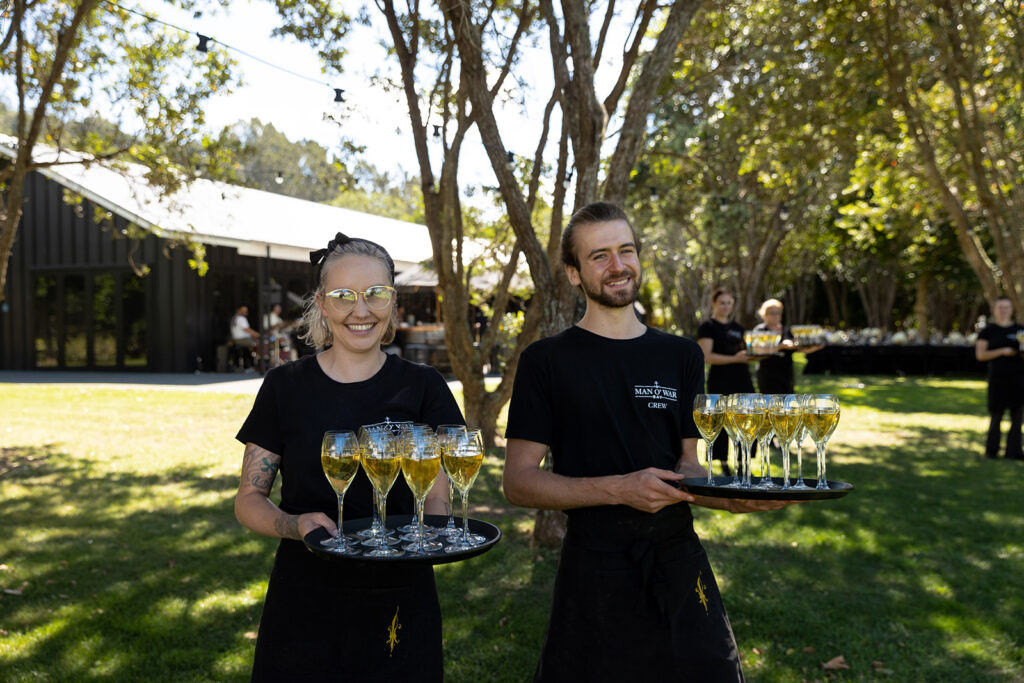
WF: And with the right food – that’s just a great wine. Waiting for grilled salmon and asparagus.
DM: Moving on to Syrah – and we find the serving temperature of Syrah really important – the cooler the better. And for powerful, complex wines – if they are too warm you just don’t enjoy them. We have a selection of sites that are Dreadnought, and anything else, depending on the vintage will either be rosé or go into an Estate Syrah. 2013 has an element of stems in this wine, but, to me, after this vintage it was something that we really wanted to start homing in on.
WF: I like the ying and yang in this – delicate on top, but robust at the back, and that peaty note through the middle is fabulous.
DM: We saw that in the early Syrahs. As the vineyards have matured we’re seeing a lot more primary fruit characters. I think it is a bit of a vine age thing. We were very smoky bacon, peat bog, scotch whisky, kind of complex notes. Now we’re getting complexity from other aspects, depending on what we do.
WF: It’s as much about those other things, like tannin, and green stem notes, as it is about the fruit. That’s what makes it have personality.
DM: All of our fermentation ideals, whether it is Sauvignon Blanc in barrel, or Syrah, is about trying to coax out those savoury elements, and that’s what we’re after. (Brings out the dust-encrusted Syrah from 2015 refered to earlier). I’m not sure what this will be like – this is Bruno Lorenzon, the Head Cooper at Mercurey – he designed these untoasted barrels.
Marcel and Sherwyn bring these barrels in, and I don’t know who else is using them, but we’ve been trying them since 2015. This is 100% whole berry, destemmed. The thought is that we get some of the energy from the barrel that we couldn’t from the stems, because of the vintage.
In answer, in apart, to your question about how long have we been playing around with Kulta – this is part of that process. Could have bottled it and released it, but I thought it was more of a useful experiment to understand those types of barrels for Syrah. I think we bottled twelve bottles and then clearly forgot them.
WF: Any thoughts on things like 100 point scores, and stuff like I do – giving my thoughts on wines?
DM: The scores almost don’t matter. It can be 88 or it can be 98, but if the words describe exactly what I’m tasting, then that is worth it – because I know the wine. One of the coolest things about people writing about wine is that there is space for everyone. The points are almost a distraction. You know people have what is called ‘shower thoughts’? I was at the locked gate the other day, and I swung the gate open, and I was about to get back in my truck… and I suddenly thought ‘how does anyone, ever, score a wine 100 points?’ And I stood there, and I thought about it. And I fucked around, thinking about it. And then I got back in my truck and drove through the gate. I just don’t get how a wine can be perfect. But… if the wine critic writes ‘absolutely sublime’ – then I want to drink that.
